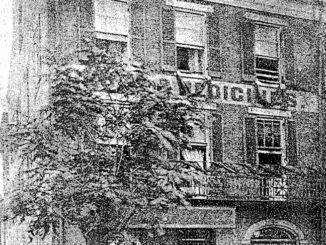
The memory cells in our brain are a haven to a wealth of facts, impressions, feelings and beliefs. We billet these facts until something triggers them and suddenly they command our attention once again. When that happens, it is often difficult to associate facts from beliefs or feelings from impressions, but together they enter our conversation once again. Such an occasion happened to me not long ago.
I was escorting visitors to our community through the antique stores in Smiths Grove. We found a delightful coverlet hanging on one of the walls. It depicted scenes famous throughout Bowling Green and Warren County. Having visited many of the locations, the group stopped to examine each of the blocks to review where they had been. They remembered going to Hobson House, visiting on Western’s campus, passing the courthouse, and enjoying Fountain Square. They had not yet visited Lost River. When they came to the block in the lower left corner, they expressed confusion. What was the Clay Street House? Yes! Ah! How does one briefly explain the Clay Street House to strangers?
How does one explain how a single mother with children can make a living in the 1930s? How does one realize the pressures facing a cultured, respected individual faced with the possibility of poverty? Pauline Tabor was such an individual. Born April 1905, she grew up in a respectful middle-class home. Like many young ladies of her time, she lived a shielded lifestyle, closely guarded, and was casually informed about relationships with others. Married at eighteen and later mother of two children, she found herself divorced with no means of support for herself or her boys. After several attempts at door-to-door sales and various other enterprises, she discovered she was not able to make a successful living. With her keen sense of business knowledge, she observed the potential of female companionship for the opposite sex and realized this would be a profitable opportunity for her to manage.
Mrs. Tabor talked with local prominent leaders, assessed the community needs, studied business requirements and, after several events, opened the Clay Street residence as Bowling Green’s prime establishment catering to needs of gentlemen. The attempt was an immediate success and continued to be for several years. In fact, Clay Street was the third longest-running establishment in the United States. The Dumas Hotel in Butte, Montana ran continuously as a house from 1890-1982 and in second place the Chicken Ranch, better known as the “Best Little Whorehouse in Texas,” ran from 1905-1973.
The Clay Street House even became known nationally. Situated in Bowling Green, it was located near the state college. It was within reach of service men from Fort Campbell and Fort Knox. These institutions included individuals from many different cities and different states. The knowledge of the house in Bowling Green was carried far and wide across the nation and its reputation grew.
Pauline’s success with this establishment was due to her diligent and respectful care of business. She never allowed trouble to be present. She demanded the principles of cleanliness and decency to rule. She kept in contact with community concerns to follow necessary regulations. She was aware of area opposition and attitudes of individuals and groups, but she made sure in serving a need of the community, her efforts were with dignity and without pretense. She was one of the most generous, unselfish members of the community. She aided small children in need regularly, providing clothing and food to families. Pauline supported individuals facing their burned-out home or persons whose help with mortgage payments was desperately needed. As a result, she was viewed as a gracious and talented woman by those who knew her personally. She gave generously to community efforts and always maintained a gentle and kind persona. She was truly magnanimous.
The Clay Street house may be listed by some as a contemptible chapter in the history of our city. As a house of ill-repute, it dealt with the most basic need of mankind. It opened at a time when the community atmosphere was not as open and tolerant as it is today. The depression had limited employment and working opportunities for women were very limited. Mrs. Tabor accessed the community needs and found a way to address them. She was a shrewd businesswoman and managed the business while building a reputation as a respected, benevolent personality. She was a happy, positive person, and a lovely friend to family and community members. She operated her business at a time in history when morals were different, but because of her magnificent personality was able to become memorable in the history of Bowling Green.
The little red house at 627 Clay Street was discontinued in 1969 when the house was destined for urban renewal. Her appearance on the Dick Cavett Show after her retirement continued the national awareness of this madam. She lived her final years in a home in University City, Texas where she had moved in the mid-1970s to be near her son. At her funeral in June 1992, all three television news stations, ABC, NBC and CBS, arrived in Bowling Green to cover the event of this nationally recognized person. Even the New York Times and The Times of London requested information about “Pauline” to publish in their newspapers.
When in her forties, Mrs. Tabor married Paul Webster. In 1951 her dream of living on a farm became a reality with the ownership and management of an organic farm. Together they each continued a dual occupation, Paul as a farmer and bookmaker, Pauline as a farmer and madam. In 1971 she had her life at the “little red house” recorded in her book, “Pauline’s.” It was a frank presentation of lifestyle at the Clay Street House with no apologies or excuses. The book naturally did not name individuals but did describe the personalities and experiences of staff and visitors. It obviously became a big seller, as were the bricks that were sold by enterprising young businessmen when the “little red house” was demolished.
Pauline Tabor Webster will always be remembered by some as the notorious madam of a famous brothel but will be respected locally by many friends and family as the gentle, generous lady she was. The coverlet with the corner square picturing the Clay Street House still exists recognizing this historical landmark.
-by Mary Alice Oliver
About the Author: Mary Alice Oliver is a Bowling Green native who is a 1950 graduate of Bowling Green High School. She retired from Warren County Schools after 40 years in education. Visiting familiar sites, researching historical records and sharing memories with friends are her passions.
Publisher’s Note: Those of you who have been SOKY Happenings fans for years might recognize this as a reprint from 2017. Mary Alice is taking a well-earned month off and the SOKY Happenings editorial team felt this was a perfect repeat for the Month of Love. Hopefully you will enjoy revisiting one of Ms. Oliver’s best efforts.







